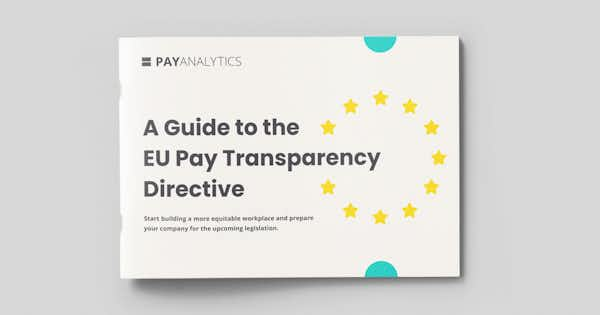Preparing for the EU Pay Transparency Directive | Download our E-book for free

The Netherlands introduces draft legislation to transpose the EU Pay Transparency Directive
In spring of 2025, the Netherlands introduced draft legislation that would fully transpose the EU Pay Transparency Directive by amending existing laws. This article examines what those changes would involve.
Pay equity and transparency landscape in the Netherlands
In terms of its gender pay gap, the Netherlands is roughly on par with the EU average. For the last few years, its unadjusted gap has measured around 13%.
Since 1997, Dutch law (specifically, the Civil Code) has explicitly forbidden pay discrimination based on gender. Otherwise, existing legislation to date has focused on pay transparency in organizations with 100 or more employees. Companies of this size are required to have an annual consultation with their works council (which is a body of elected representatives who advocate for employees’ interests). This discussion must include a comparison of the employer’s rewards data and gender pay ratios with data from the previous year.
With the transposition deadline for the EU Pay Transparency Directive on the horizon, the Netherlands introduced draft legislation in late-March2025.
In our free e-book we break down the EU Pay Transparency Directive. Get your complimentary copy to be on top of all the requirements and assess how ready your company is for compliance.
Transposition updates: Draft legislation introduced
This draft legislation would fully transpose the EU Directive by amending the Equal Treatment Act for Men and Women, the Works Councils Act, and the Allocation of Labor by Intermediaries Act. The legislation stays fairly close to the basic requirements of the EU Directive (see ourpocket guide) in terms of both pay transparency and pay equity, with some slight modifications.
Pay transparency requirements
The Dutch draft legislation would establish the following pay transparency requirements in line with the Directive:
- Employers must share the starting pay or pay range of each position with candidates in the job post or prior to the first interview.
- Employers may not ask candidates about their pay history.
- Employees can talk about their pay without facing any kind of adverse action.
- If an employee requests it, the employer must provide information about pay ranges for categories of workers doing the same work or work of equal value.
- Also on request, the employer must provide a comparison between the individual employee’s pay and the pay of comparable employees.
- Pay decisions must be based on gender-neutral, objective criteria.
The EU Directive specifies that these pay transparency requirements apply to organizations with 100 employees or more. However, the Netherlands draft legislation would apply them to employers of all sizes. It would also specify that while all employers must use gender-neutral, objective criteria to drive their pay decisions, those with 50 or more employees must also provide employees with access to those criteria.
Pay equity requirements
The Directive requires that organizations define “categories of workers doing the same work or work of equal value” within their organization. Within each category, employers will need to report the following gender pay gap metrics. These pay gap measurements can be adjusted based on gender-neutral factors like performance and experience.
The specific gender pay gap reporting requirements are:
- the gender pay gap.
- the gender pay gap in complementary or variable components.
- the median gender pay gap.
- the median gender pay gap in complementary or variable components.
- the proportion of female and male workers receiving complementary or variable components, broken down by gender.
- the proportion of female and male workers in each quartile pay band, broken down by gender.
- the gender pay gap between workers by categories of workers broken down by ordinary basic salary and complementary or variable components.
- the proportion of workers who benefited from a pay rise following their return from maternity leave, paternity leave, parental leave, and carers’ leave broken down by gender.
- the average pay levels by category of workers broken down by gender.
The Directive also gives employees the right to see their employer’s pay gap information, places the burden of proof on the employer in the event of a dispute, and specifies remediation measures if the employer’s pay gap (adjusted, as mentioned, for gender-neutral factors) is above 5%.
In its pay equity provisions, the Netherlands draft legislation would go a little beyond the Directive in the following ways:
- It would specify the compensation types that employers would need to include in their reports. Examples include use of a company car, overtime or holiday pay, training allowances, bonuses, or shares.
- If an employee requests salary information by gender and employee category, the employer would be required to provide it within two months.
- The draft legislation states that company management must certify the pay gap information that is reported. It also outlines the involvement of the employer’s works council, which would need to approve elements of the pay structure as well as plans for remediating any pay gaps over 5%.
Deadlines for pay gap reporting:
- June 7th, 2027: Employers with 150 or more employees
- June 7th, 2031: Employers with 100 to 149 employees
Further support with PayAnalytics by beqom
Pay equity analysis
Proactive employers in the Netherlands will want to bring their pay gaps below 5% by the time the final legislation takes effect. Now is a great time to get started! Our software solution helps employers close their pay gaps in a way that’s cost-effective and on your desired timeline. And beyond just the pay gaps, PayAnalytics by beqom also gives you an overview of your whole pay structure, with drill-down capabilities to help you identify where it may need to change. This gives you the power you need to revamp your pay structure – or develop one from the ground up – to make sure it’s based on objective, gender-neutral criteria as outlined in the legislation.
Compensation assistant
Once you shrink your pay gap or close it completely, you’ll want to protect the investment of your time and effort. PayAnalytics by beqom provides ongoing decision support to make sure that the pay gap you worked so hard to eliminate will never reappear.
Additional resources
- To check your organization's readiness status to comply with the Directive and a set-by-step compliance guide, get our free checklist.
- For more details about what the EU Pay Transparency Directive includes, download our free eGuide.
And if you’d like to see for yourself how our platform works, you can book a demo with one of our pay equity experts.





